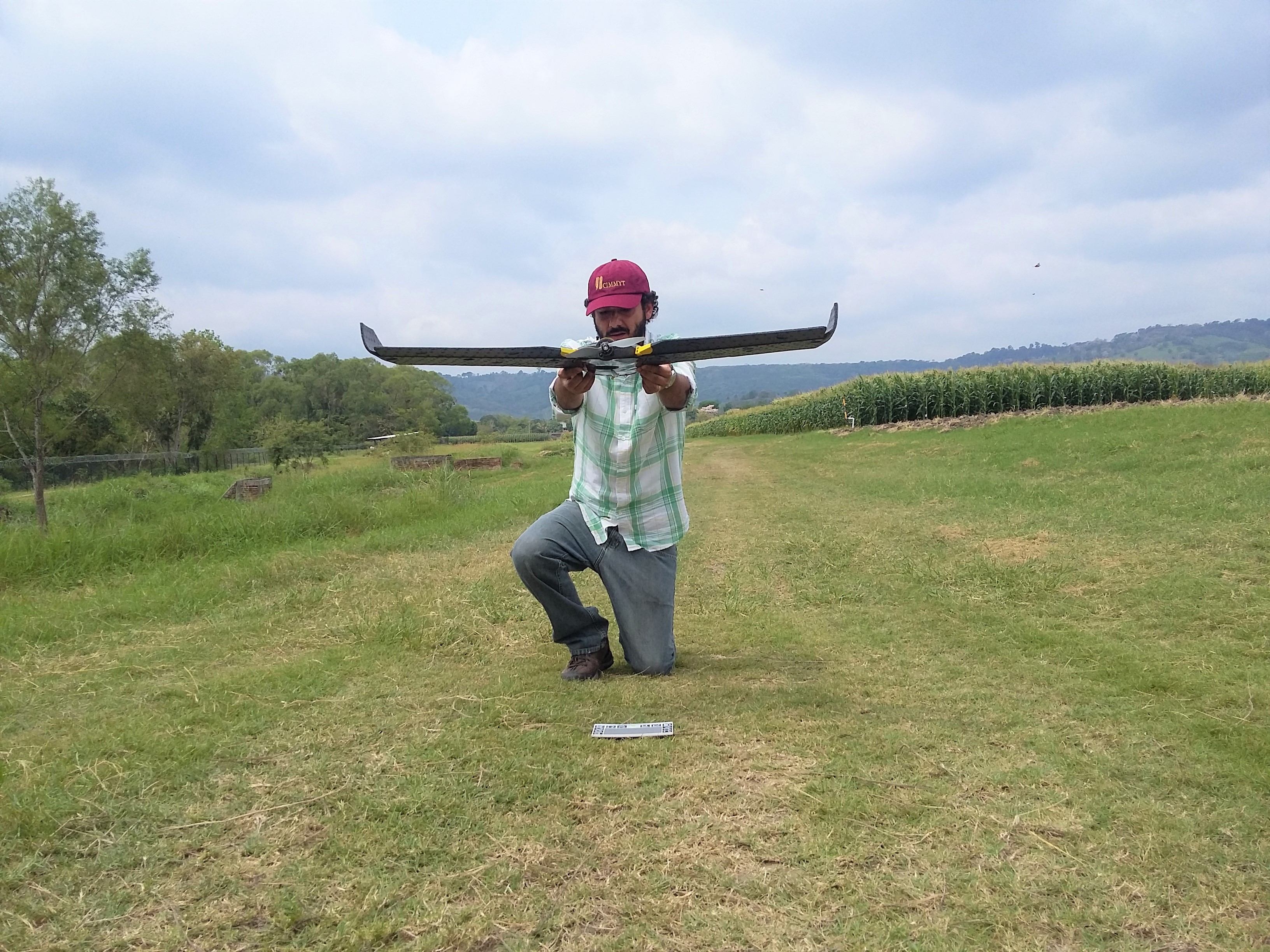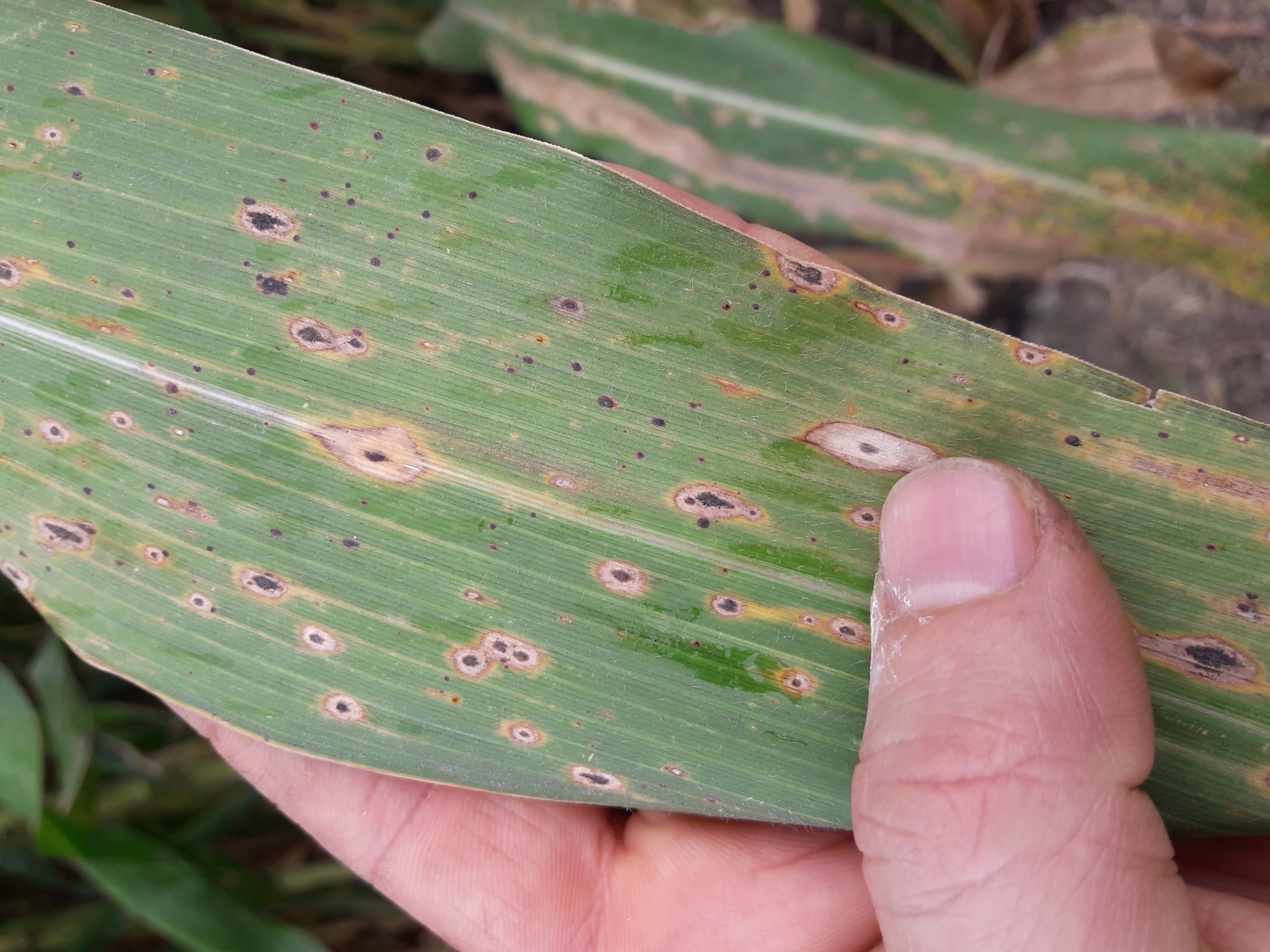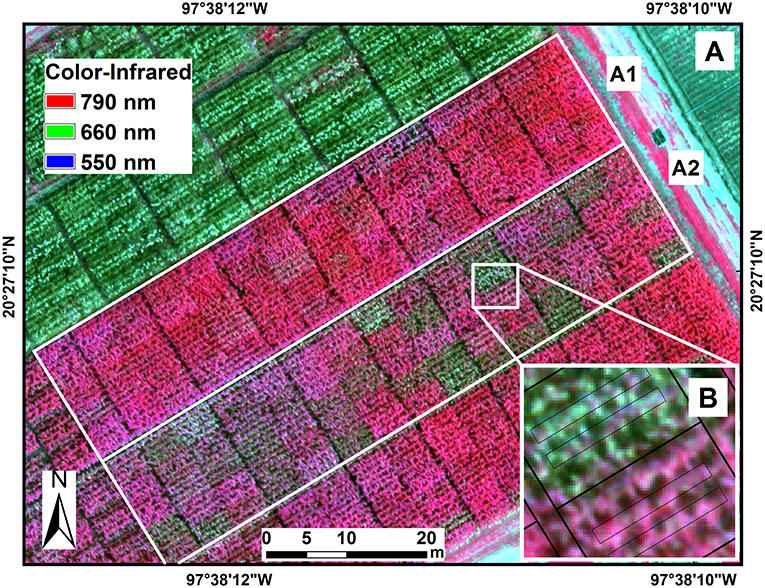June 20, 2019
by Carolyn Cowan
 Francelino Rodrigues prepares an UAV for radiometric calibration for multispectral flight over a maize tar spot complex screening trial at CIMMYT’s Agua Fría experimental station, Mexico. (Photo: Alexander Loladze/CIMMYT)
Francelino Rodrigues prepares an UAV for radiometric calibration for multispectral flight over a maize tar spot complex screening trial at CIMMYT’s Agua Fría experimental station, Mexico. (Photo: Alexander Loladze/CIMMYT)
A new study from researchers at the International Maize and Wheat Improvement Center (CIMMYT) shows that remote sensing can speed up and improve the effectiveness of disease assessment in experimental maize plots, a process known as phenotyping.
The study constitutes the first time that unmanned aerial vehicles (UAVs, commonly known as drones) with cameras that capture non-visible electromagnetic radiation were used to assess tar spot complex on maize.
The interdisciplinary team found among other things that potential yield losses under heavy tar spot complex infections could reach 58% — more than 10% greater than reported in previous studies.

Caused by the interaction of two fungal pathogens that thrive in warm, humid conditions, tar spot complex is diagnosed by the telltale black spots that cover infected plants. (Photo: Alexander Loladze/CIMMYT)
“Plant disease resistance assessment in the field is becoming difficult because breeders’ trials are larger, are conducted at multiple locations, and there is a lack of personnel trained to evaluate diseases,” said Francelino Rodrigues, CIMMYT precision agriculture specialist and co-lead author of the study. “In addition, disease scoring based on visual assessments can vary from person to person.”
A major foliar disease that affects maize throughout Latin America, tar spot complex results from the interaction of two species of fungus that thrive in warm, humid conditions. The disease causes telltale black spots on infected plants, killing leaves, weakening the plant, and impairing ear development.
Phenotyping has traditionally involved breeders walking through crop plots and visually assessing each plant, a labor-intensive and time-consuming process. As remote sensing technologies become more accessible and affordable, scientists are applying them more often to assess experimental plants for desired agronomic or physical traits, according to Rodrigues, who said they can facilitate accurate, high-throughput phenotyping for resistance to foliar diseases in maize and help reduce the cost and time of developing improved maize germplasm.
“To phenotype maize for resistance to foliar diseases, highly trained personnel must spend hours in the field to complete visual crop evaluations, which requires substantial time and resources and may result in biased or inaccurate results between surveyors,” said Rodrigues. “The use of UAVs to gather multispectral and thermal images allows researchers to cut down the time and expenses of evaluations, and perhaps in the future it could also improve accuracy.”

Color-infrared image of maize hybrids in the experimental trials under fungicide treatment (A1) and non-fungicide treatment (A2) of tar spot complex of maize. Image data were extracted from two polygons from the two central rows in each plot (B).
Technology sheds new light on phenotyping
Receptors in the human eye detect a limited range of wavelengths in the electromagnetic spectrum — the area we call visible light — consisting of three bands that our eyes perceive as red, green and blue. The colors we see are the combination of the three bands of visible light that an object reflects.
Remote sensing takes advantage of how the surface of a leaf differentially absorbs, transmits and reflects light or other electromagnetic radiation, depending on its composition and condition. The reflectance of diseased plant tissue is different from that of healthy ones, provided the plants are not stressed by other factors, such as heat, drought or nutrient deficiencies.
In this study, researchers planted 25 tropical and subtropical maize hybrids of known agronomic performance and resistance to tar spot complex at CIMMYT’s experimental station in Agua Fría, central Mexico. They then carried out disease assessments by eye and gathered multispectral and thermal imagery of the plots.
This allowed them to compare remote sensing with traditional phenotyping methods. Calculations revealed a strong relationship between grain yield, canopy temperature, vegetation indices and the visual assessment.
Future applications
“The results of the study suggest that remote sensing could be used as an alternative method for assessment of disease resistance in large-scale maize trials,” said Rodrigues. “It could also be used to calculate potential losses due to tar spot complex.”
Accelerated breeding for agriculturally relevant crop traits is fundamental to the development of improved varieties that can face mounting global agricultural threats. It is likely that remote sensing technologies will have a critical role to play in overcoming these challenges.
“An important future area of research encompasses pre-symptomatic detection of diseases in maize,” explained Rodrigues. “If successful, such early detection would allow appropriate disease management interventions before the development of severe epidemics. Nevertheless, we still have a lot of work to do to fully integrate remote sensing into the breeding process and to transfer the technology into farmers’ fields.”
Funding for this research was provided by the CGIAR Research Program on Maize (MAIZE).
Read the full article:
Loladze A, Rodrigues FA Jr, Toledo F, San Vicente F, Gérard B and Boddupalli MP (2019) Application of Remote Sensing for Phenotyping Tar Spot Complex Resistance in Maize. Front. Plant Sci. 10:552. doi: 10.3389/fpls.2019.00552